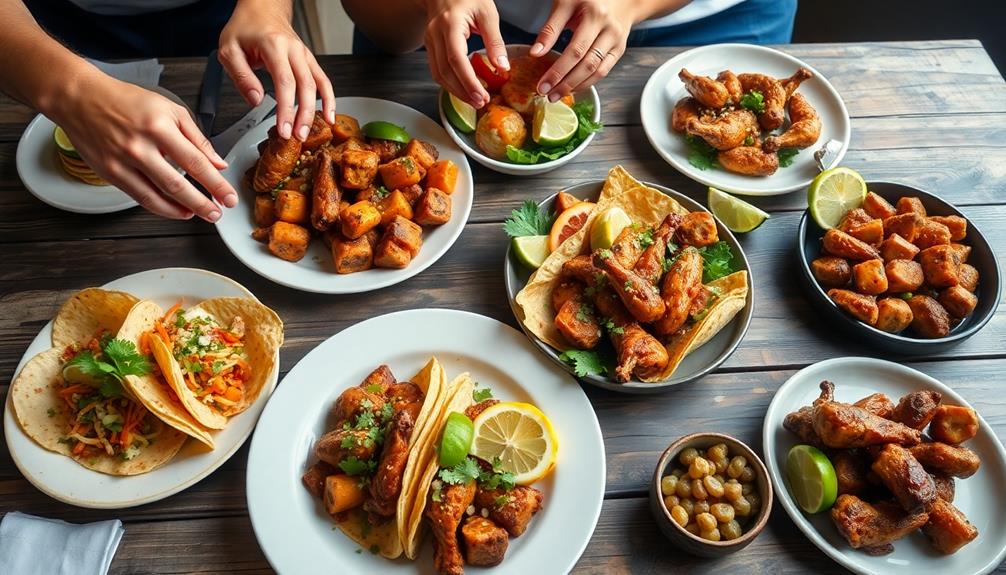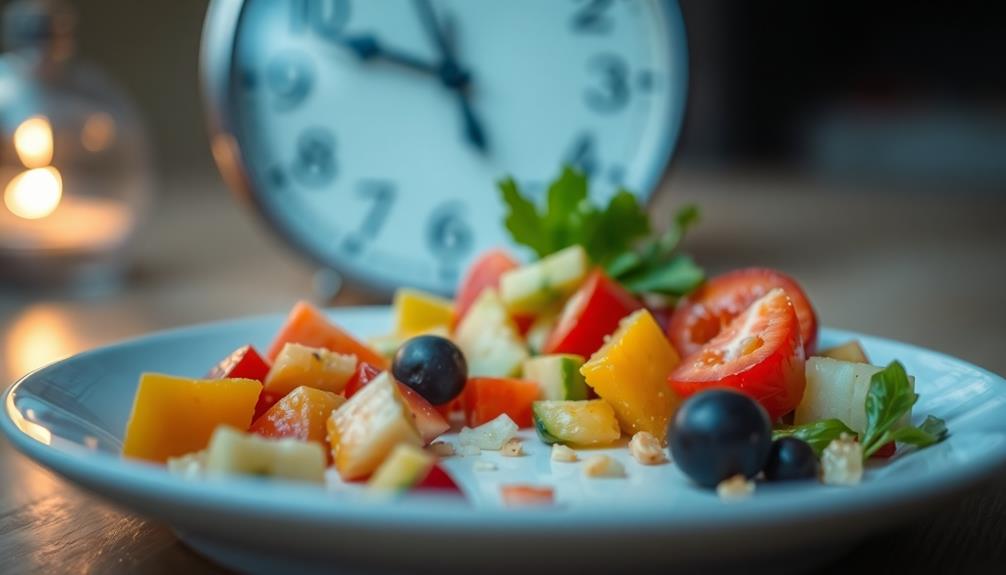Some foods taste better when you eat them with your hands because it enhances your sensory experience. Engaging with food through touch helps you appreciate its textures and temperatures, boosting flavor perception. This tactile interaction also fosters mindfulness, making each bite more enjoyable and satisfying. Plus, hand eating often connects you to cultural traditions, creating a sense of community and shared experience. The warmth and intimacy of communal dining can turn a simple meal into a memorable feast. If you’re curious about how this practice shapes our dining experiences, there’s much more to explore on this topic.
Key Takeaways
- Eating with hands enhances tactile interaction, allowing better appreciation of food’s textures and temperatures, which intensifies flavor perception.
- The act of hand eating promotes mindfulness, fostering a deeper emotional connection to food and enriching the overall dining experience.
- Sharing food by hand creates a sense of community, making meals feel more personal and memorable, which can enhance enjoyment.
- Direct contact with food evokes nostalgic memories and emotional responses, making the eating experience more satisfying and meaningful.
- Hand eating encourages slower consumption, allowing for better digestion and a greater appreciation of flavors with each bite.
Cultural Practices of Hand Eating
Eating with your hands is more than just a method; it’s a rich cultural practice deeply rooted in various societies around the world. In countries like India and Ethiopia, this tradition fosters a sense of community and shared experiences during meals.
Ethiopian cuisine, with its unique dishes like Yeselata (Ethiopian Salad) and Yetimatim Fitfit, exemplifies how hand eating enhances the enjoyment of flavorful, communal dining. When you dine in these cultures, you’ll often notice that only the right hand is used for eating, as the left hand is considered taboo. This practice emphasizes respect and cultural etiquette, especially during communal dining.
Rituals such as washing hands before meals are common in hand-eating cultures, symbolizing cleanliness and care for food. This simple act enhances the overall dining experience and shows appreciation for the meal.
In the Philippines, the kamayan tradition allows you to enjoy food without utensils, reinforcing social bonds and cultural identity as everyone shares in the meal together.
Historically, hand eating predates utensils, highlighting ancient culinary traditions that shape contemporary dining practices. By engaging in these cultural practices, you’re not just enjoying a meal; you’re participating in a rich heritage that connects you to generations past, making each bite more meaningful.
Sensory Engagement With Food
When you eat with your hands, you engage your sense of touch in a way that transforms your meal.
This experience is particularly evident when enjoying dishes like Chinese Steamed Egg or Cumin Lamb, where the textures and warmth are integral to the flavors.
Feeling the textures and temperatures of your food enhances your flavor perception, making each bite more enjoyable.
This tactile interaction not only deepens your connection to the meal but also enriches the overall dining experience.
Tactile Interaction Benefits
While you might think cutlery is essential for a proper meal, engaging with food using your hands can greatly enhance your sensory experience. Tactile interaction allows you to appreciate the textures and temperatures of your food more vividly than with forks and knives.
For instance, dishes like Mushroom Masala or Gobi Manchurian can be more enjoyable when you can feel their unique textures before tasting them. When you eat with your hands, you engage multiple senses, promoting mindfulness that leads to greater enjoyment and satisfaction with each bite.
This physical engagement fosters a deeper connection to your meal, letting you experience the dish as a whole rather than just its individual components. Grasping and mixing food creates intimacy, making every bite feel more personal and memorable.
In fact, studies suggest that this direct contact can evoke emotional responses, stirring up nostalgia and cultural ties that enhance your overall dining experience.
Moreover, eating with your hands encourages slower consumption, which not only aids digestion but also helps you better gauge portion sizes. By savoring each bite, you can truly appreciate the meal, leading to a more enjoyable and mindful eating experience.
Enhanced Flavor Perception
Engaging with food using your hands not only creates a tactile connection but also greatly enhances flavor perception. When you choose eating with the hands, you’re not just savoring the taste; you’re experiencing the food’s texture and temperature up close. This intimacy can intensify your enjoyment, making each bite feel richer and more satisfying.
For instance, dishes like Caldeirada allow for a hands-on experience that deepens your connection to the rich flavors and fresh seafood typical of Brazilian cuisine.
Studies show that touching your food can evoke emotional responses and nostalgic memories, deepening your appreciation for the meal. By grasping food with your fingers, you promote mindfulness, allowing you to slow down and be aware of the various flavors and textures in each bite. This direct contact alters taste perception, making flavors more pronounced than when using utensils, which can create a barrier between you and your food.
Additionally, hand-eating fosters a relaxed and informal atmosphere, enhancing social interaction and enjoyment during meals. Sharing food in this way can amplify the sensory experience of flavors and aromas, transforming a simple meal into a memorable feast.
Psychological Benefits of Touch
When you eat with your hands, you tap into a richer sensory experience that heightens your appreciation for texture and temperature.
For instance, enjoying a plate of crispy onion rings can enhance this tactile interaction, as the crunch and warmth engage your senses.
This tactile interaction fosters mindfulness, helping you stay present and savor each bite.
As you engage more fully with your meal, you not only enjoy it more but also cultivate a deeper emotional connection to the food.
Enhanced Sensory Engagement
Eating with your hands offers a unique sensory experience that can profoundly enhance your connection to food. When you engage in eating with your hands, you create a tactile connection that allows you to appreciate textures and temperatures on a deeper level.
For instance, enjoying a dish like Nettle and Potato Soup can feel even more satisfying when you scoop it up with your hands, as the warmth and creaminess become part of the experience. This enhanced sensory engagement activates multiple senses—sight, smell, and touch—making each bite more flavorful and enjoyable.
Studies show that when you grasp your food, it encourages a slower eating pace, aiding digestion and leading to greater satisfaction. You’re not just consuming; you’re experiencing. This tactile interaction doesn’t just fill your stomach; it can evoke emotional responses and nostalgia.
The physical act of hand-eating often brings back warm memories of family gatherings and cultural traditions. Research in gastrophysics supports this notion, indicating that the sensory engagement of eating with hands can elevate your overall enjoyment of food.
Mindfulness and Presence
Mindfulness and presence during meals can be greatly enhanced through the simple act of eating with your hands. When you engage your tactile senses, you become more aware of the textures and temperatures of your food, deepening your experience. This practice fosters a connection to your meals, often evoking memories tied to family gatherings or cultural traditions.
| Sense Engaged | Effect on Eating |
|---|---|
| Touch | Enhances texture awareness |
| Smell | Amplifies aroma perception |
| Sight | Increases visual appeal |
| Taste | Boosts flavor enjoyment |
Social Connections and Community
Engaging in communal dining, especially through the act of eating with your hands, creates a unique atmosphere that fosters social connections. When you share a meal, it’s not just about the food; it’s about the bonds you strengthen with others.
In cultures like India and Ethiopia, hand-eating rituals highlight respect for the host and deepen community ties. This practice diminishes social barriers, making meals feel more intimate and inclusive. For example, enjoying dishes like Kawarma can enhance the experience, as the rich flavors encourage shared enjoyment and conversation.
Here are three ways you can enhance your communal dining experience:
- Encourage Sharing: Serve dishes that are meant to be shared, allowing everyone to partake and engage with one another.
- Create a Comfortable Environment: Set the table in a way that invites conversation and connection, perhaps by using soft lighting or comfortable seating.
- Incorporate Hand-Eating Traditions: Embrace hand-eating customs from various cultures, as these can evoke feelings of nostalgia and comfort, reinforcing connections among family and friends.
Hygiene and Health Considerations
When it comes to enjoying meals with your hands, hygiene and health considerations play a crucial role. Before digging into your meal, you should always wash your hands thoroughly to minimize the risk of foodborne illnesses.
Many cultures incorporate specific rituals for cleanliness that enhance both health and hygiene, making the experience more enjoyable. For instance, traditional dishes like Muamba De Galinha in Angola are often enjoyed with hands, emphasizing the importance of fresh ingredients and cleanliness.
Engaging in hand-eating can promote mindfulness, allowing you to savor each bite more consciously. This mindfulness can lead to better digestion and greater overall satisfaction with your meal, but only if you practice good hygiene. Using clean, fresh ingredients is essential in hand-eating cultures, where food safety rituals are often observed prior to meals.
While some people may have concerns about hygiene when eating with their hands, it’s important to remember that many cultures highlight the health benefits of this practice. Staying aware of food safety practices, such as using utensils for certain dishes while incorporating hand-eating, can help you mitigate health risks.
Modern Trends in Dining
Casual dining is booming, and you’re likely noticing more finger foods on menus everywhere.
This trend aligns well with traditional street foods, such as Khanom Tan, which are designed to be enjoyed without utensils.
Social media plays a huge role here, showcasing those mouthwatering hand-eating moments that make you want to share your dining experiences.
As restaurants embrace this trend, it’s clear that eating with your hands is becoming a popular way to enjoy meals.
Casual Dining Experiences
As dining preferences shift toward a more relaxed atmosphere, the rise of casual dining experiences has transformed how people connect with their food. More and more restaurants now feature finger foods and shareable platters, encouraging you to engage intimately with your meals.
This trend embraces hand-eating, making it a staple of modern dining. Traditional dishes, like chilaquiles, often served as breakfast, highlight the joy of eating with your hands while enjoying vibrant flavors.
Here are three ways to enjoy these casual dining experiences:
- Explore Food Festivals: Visit local food festivals to sample a variety of finger foods from different cuisines. These events often highlight communal dining, fostering a sense of community.
- Try Shareable Platters: Choose restaurants that offer shareable platters. This allows you and your friends to taste multiple dishes while enjoying the tactile experience of eating with your hands.
- Experiment with Hand-Friendly Menus: Seek out eateries that focus on hand-friendly dishes. Chefs are increasingly crafting menus that emphasize the joy of eating with your hands, enhancing your overall sensory experience.
As you explore these casual dining experiences, you’ll discover the delight of connecting with food in a more personal and enjoyable way.
Social Media Influence
Social media has transformed how we experience dining, turning meals into shareable moments that invite engagement. Platforms like Instagram have fueled the popularity of visually appealing hand-eating experiences, making it a trend you won’t want to miss.
When you eat with your hands, you’re not just enjoying your food; you’re creating an opportunity to showcase it. This informal style is perfect for capturing those Instagram-worthy shots that your followers crave.
The rise of food festivals and pop-up restaurants emphasizing hand-eating reflects this shift. These events attract crowds enthusiastic for interactive and shareable dining experiences.
Many restaurants have also adapted their menus, incorporating finger foods and shareable platters that encourage communal dining, all highlighted on social media.
Influencers and food bloggers play a pivotal role in promoting these trends, pushing for less formal dining etiquette and more tactile engagement with food.
The aesthetic appeal of hand-eaten dishes, presented in unique ways, has become a significant factor in marketing strategies.
Historical Context of Hand Eating
Eating with your hands has deep roots that stretch back to ancient civilizations, where it was the primary way to enjoy meals before utensils came onto the scene. In many cultures, using your hands is the norm, reflecting a direct and intimate connection to your food.
Historical evidence shows that communal eating practices involving hand eating played a significant role in fostering social interactions among family members and friends.
Here are three key aspects of the historical context of hand eating:
- Cultural Significance: In countries like India and Ethiopia, hand eating is woven into traditional rituals, emphasizing respect by washing hands and using only the right hand for meals.
- Communal Bonding: Sharing food by hand has been a way to signify love and hospitality, particularly in practices like the Bangladeshi makhani, where mixing food with hands is a cherished tradition.
- Generational Legacy: This practice has been preserved over generations, highlighting its importance in creating familial ties and community connections that continue to influence how people dine today.
Family Traditions and Rituals
Hand-eating traditions within families create a unique bond that enhances the dining experience. When you gather around the table for communal meals, you’re not just sharing food; you’re building connections. These meals often highlight family traditions, where everyone participates in the act of eating with their hands, fostering a sense of togetherness.
As a child, you may have watched your parents eat this way, and now you find yourself encouraging your own kids to do the same. This ritual not only strengthens familial ties but also creates lasting memories around shared dishes.
Celebratory meals often incorporate hand-eating rituals, allowing you to engage with your cultural heritage while deepening emotional bonds. One poignant act during family gatherings is feeding one another by hand. This simple gesture symbolizes love and care, reinforcing those connections.
Additionally, rituals like washing hands before meals signify respect and cleanliness, adding to the significance of the dining experience. Through these traditions, the act of eating becomes more than just nourishment; it transforms into a celebration of family, culture, and togetherness.
Flavor Perception and Enjoyment
Gathering around the table with family not only strengthens bonds but also heightens the sensory experience of meals. When you eat with your hands, you engage your sense of touch, allowing you to better appreciate the textures and temperatures of your food.
This tactile interaction greatly enhances your flavor perception, making the dining experience more enjoyable.
Here are three ways to amplify your enjoyment when eating with your hands:
- Savor Each Bite: Slow down and focus on the flavors and textures of your food. This mindfulness can lead to greater appreciation and satisfaction.
- Explore Different Textures: Embrace the variety in your meal. Touching and feeling your food can evoke emotional responses, making flavors feel more pronounced.
- Create Personal Connections: Reflect on your cultural associations with hand-eating. Familiarity can enhance your emotional connection to food, positively impacting how you perceive its flavor.
Changing Attitudes Towards Hand Eating
Why have attitudes toward hand eating shifted so dramatically in recent years? You might notice that more people are embracing finger foods, thanks to cultural appreciation and the influence of social media. Instagram showcases visually appealing hand-eating experiences, making it cool to share platters and finger foods. This trend has even found its way into fine dining, where casual dining norms relax traditional etiquette.
Here’s a quick look at how hand eating is changing perceptions:
| Factor | Traditional View | Current View |
|---|---|---|
| Dining Etiquette | Use utensils primarily | Embrace hand eating |
| Cultural Practices | Limited to specific cuisines | Diverse global influences |
| Social Media | Minimal impact | Major platform for sharing |
As you engage with food using your hands, you create a deeper connection with it and those around you. Mindfulness in dining enhances sensory enjoyment, making hand eating feel even better. The stigma surrounding it is fading, making way for inclusive dining experiences that celebrate tactile connections. Enjoying meals this way can truly enrich your culinary journey!
Frequently Asked Questions
Why Does Food Taste Better When You Eat With Hands?
When you eat with your hands, you engage your senses more fully. This tactile connection enhances your appreciation of the food’s texture and flavor, making each bite feel richer and more satisfying than using utensils.
Why Is Eating With Hands Better?
Eating with hands creates a unique experience, blending texture and flavor. You’ll savor each bite more deeply, enjoying the tactile connection. It encourages mindfulness and evokes memories, making meals feel richer and more satisfying.
Why Is It Unsafe for People to Taste Food With Their Fingers?
Tasting food with your fingers can be unsafe because unwashed hands might transfer bacteria or dirt to the food. Always wash your hands beforehand to minimize the risk of foodborne illnesses and guarantee a safe eating experience.
Does It Matter What Hand You Eat With?
Yes, it matters what hand you eat with in many cultures. Using the right hand is often seen as respectful and proper, enhancing your connection to the meal and promoting a more enjoyable dining experience.
Conclusion
Eating with your hands can transform your meal into a richer experience. Did you know that 90% of your taste perception comes from your sense of smell? When you engage with food directly, you heighten that sensory experience, making flavors pop. Plus, sharing a meal this way fosters deeper connections with family and friends. So next time you dig in sans utensils, embrace the joy and intimacy it brings—your taste buds will thank you!









